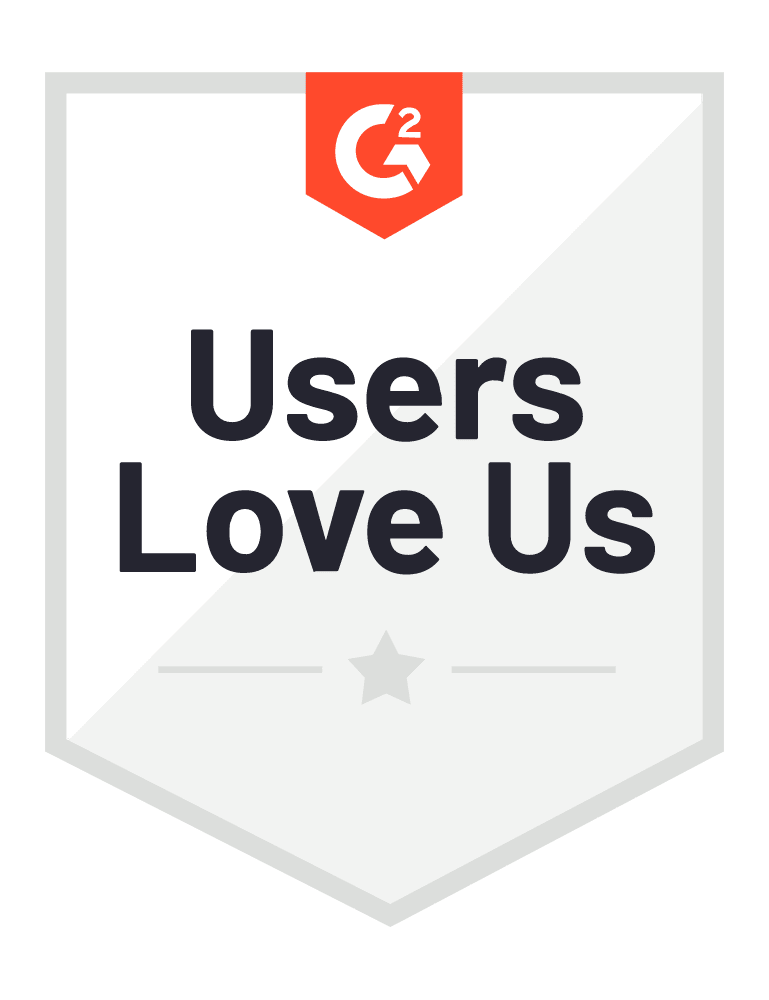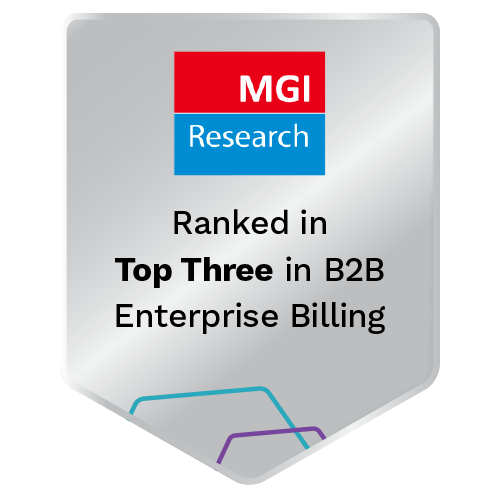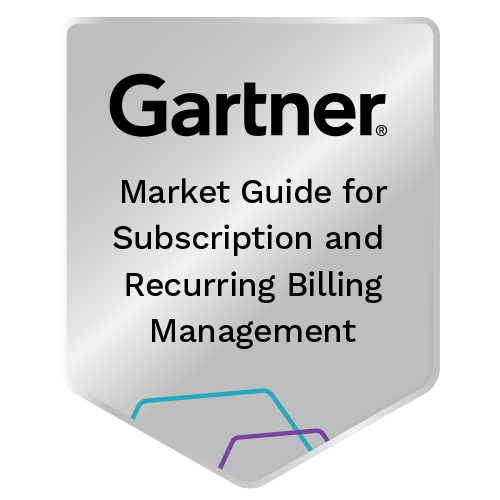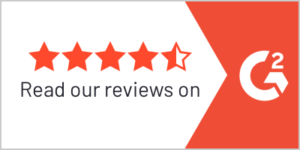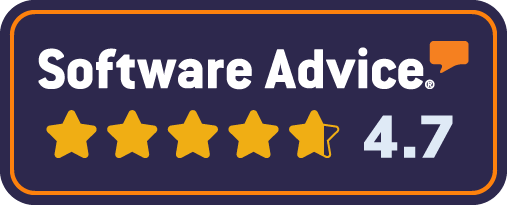Blulogix Whitepaper
Driving Growth, Customer Satisfaction, and Retention with Usage-Based Pricing
Companies are moving to usage-based pricing. After all, it promises to attract more customers, make selling easier with flexible pricing options and help reduce customer churn.
But for many, in order to capitalize on this revenue and profit boosting strategy, a roadmap is needed. One that maps out not only the “why’s,” but the “how’s.”
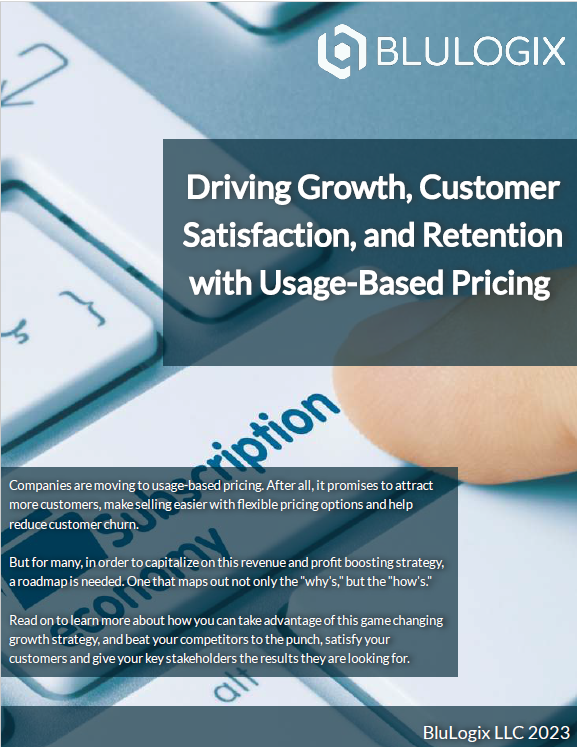
Table of Contents
Read on to learn more about how you can take advantage of this game changing growth strategy, and beat your competitors to the punch, satisfy your customers and give your key stakeholders the results they are looking for.
The economic environment today means that for many companies, change is in the wind. One potential option is usage-based pricing, a key to growth for many companies. This paper will explore the reasons for transitioning to usage-based billing, considering market conditions, evolving business models, funding challenges, and the exibility it oIers for adaptive pricing opportunities. Additionally, we’ll delve into the product-led growth challenge. For the “how” part, we will discuss data integration, rating and mediation, end- to-end process automation, and revenue and financial management.
Key Issues that Define the Discussion on Usage Billing?
Usage-based pricing is a model that aligns customer interests with actual consumption. In this approach, customers are only charged for what they use; if there’s no consumption, there’s no charge. Usage is typically measured using specific metrics such as the number of users, transactions, or data storage volume, among others. This metric should be easily quantifiable.
It’s essential to clarify that usage billing is not the opposite of subscriptions. Subscriptions establish ongoing relationships with customers, and within this framework, various charges can coexist, including fixed recurring fees, one-time charges, and usage-based charges.
Subscription serves as the overarching framework for building customer relationships, while usage billing is a pricing modality that operates within this structure. To implement a successful consumption-based pricing model, a capable billing solution is essential. This solution should efficiently process raw usage data, generating invoices, updating accounts, and providing analytics.
Usage billing finds widespread use in various industries. In the telecom sector, it has been a prominent aspect of the business for the past 50 years. Cloud infrastructure providers like AWS, Microsoft, and Google Cloud heavily rely on usage billing. The software industry also experiences an increasing reliance on usage billing, with notable companies such as Snow ake adopting it as the core of their business model.
Usage-based pricing is becoming increasingly mainstream, extending beyond utilities and telecom companies. Many businesses are exploring ways to monetize previously untapped opportunities, such as data storage, API calls, and other measurable events and outcomes. This growing trend has attracted more funding and investment into the space.
The demand for usage-based pricing is driven by several factors. Customers appreciate its equitable nature, where they pay only for what they use, promoting a fair value exchange. This approach also fosters a frictionless on-ramp engagement, as customers aren’t burdened with large upfront fees or fixed monthly charges if they aren’t actively using the service.
- Adopting usage-based pricing offers a more equitable and flexible approach for customers. They have the opportunity to try and use the service, and if satisfied, engage in a more detailed conversation. This approach removes the adoption hurdle, making it easier for customers to embrace the service.
- For vendors, usage-based billing provides a chance to capture previously unrealized value. It allows businesses to charge for actual usage, preventing revenue loss from unused resources.
- The uncertain economic environment further motivates companies to explore usage billing as a risk-hedging strategy. With fixed monthly charges, companies might reduce the number of users or engagement with the product. Usage-based billing enables them to maintain engagement while only paying for the actual usage, providing greater flexibility and cost control.
- With usage-based pricing, customers remain engaged and pay only for what they use, even if the per-unit cost is higher. This often results in a lower overall bill, making it a more appealing option.
- Many new companies in the generative AI space are showing keen interest in consumption-based pricing, contributing to its widespread adoption. This growing trend is driving the development of tools that support usage-based billing.
In response to the perceived demand and potential benefits, more companies are adopting usage-based billing models, providing customers with greater flexibility and the opportunity to align costs with actual usage. The move towards usage-based pricing reflects the ever-evolving landscape of business models and customer preferences.

Usage billing has evolved significantly over the years. In the past, it was considered complex, and few software companies offered it as an option. However, the landscape has changed, and many more companies now provide tooling for usage billing, creating a whole new market opportunity.
While determining the market size for usage billing, it’s important to understand that it’s not a separate market but a feature within the existing agile billing marketplace. Its rapid adoption makes it a crucial aspect of modern billing solutions.
What are the key characteristics of usage billing?
Let’s start with the basics. There are two major flavors of usage billing: postpaid and prepaid.
Postpaid Billing: With postpaid billing, customers sign up, provide payment information (credit card or other forms), and start using the service. At the end of the billing cycle, they receive a bill for the services they used. This model often involves pre-authorization or credit checks to ensure responsible usage.
Prepaid Billing: In contrast, prepaid billing requires customers to pay in advance for a specific amount of service usage. Once the prepaid usage is consumed, customers need to add more funds to continue using the service.
Usage billing requires careful consideration of these two models to ensure fair and efficient billing practices. It’s essential to strike the right balance between providing customers with the flexibility they desire while ensuring responsible usage and revenue collection for service providers.
Usage billing in the B2B context involves measures like credit checking and underwriting to control and contain costs. In the prepaid model, customers create an account and load it with funds, similar to a prepaid SIM card or phone service. If they exceed the available balance, they can top it up or negotiate with the service provider.
Billing, in general, can range from simple to highly complex, and usage billing is no exception. While many vendors can handle basic usage billing use cases, it becomes more intricate as requirements advance. Some vendors excel in supporting sophisticated and complex usage billing scenarios, allowing businesses to cater to diverse needs while others focus on simple pricing or one particular business model.
Complexity in Pricing
As we delve deeper into usage billing, the complexity increases, and the number of capable vendors narrows down. Some examples of complexity in usage billing include:
Minimum Spend: Ensuring proper billing even if the user does not fully utilize their allowance.
Tiered Pricing: Offering tiered pricing options based on usage thresholds. This can be progressive, where exceeding a threshold incurs a different rate, or interactive, where everything is charged at the lower rate until a certain volume is reached.
Rating: Taking external variables into account, such as peak or off-peak periods, to determine appropriate billing.
As usage billing becomes more sophisticated, businesses need the support of vendors who can handle these complexities effectively. Our extensive research and evaluation of the top vendors in this space have identified those who excel in managing advanced usage billing scenarios. These vendors empower businesses to adapt to evolving needs and offer a wide range of billing options.
Usage billing can indeed become quite sophisticated due to various factors, such as charging in different geographies with different pricing and volume purchasing agreements. It’s essential to consider the complexity arising from:
Geographic-Based Charges: Prices vary based on the location of usage.
Volume Purchasing Agreements: These apply to both B2C and B2B contexts. For B2C, it might resemble a family plan, whereas for B2B, it involves securing master pricing for multiple divisions and distributors.
Combination of Fixed and Usage-Based Plans: Many scenarios involve using both fixed and consumption- based plans. For instance, a cellular service may have a usage plan with allotted minutes and data, but users can opt for a no-limit plan with a higher fixed charge, avoiding additional usage charges.
Account specific pricing and bundling: Many B2B companies bundle solutions and offer them at a discount for specific accounts based on both flat rates and rates that vary based on commitments in specific products or product lines.
These complexities necessitate sophisticated billing solutions that can manage and handle various billing scenarios effciently. The ability to offer versatile and tailored plans becomes crucial for businesses to meet diverse customer needs.
Consumption or Usage-based Billing
Indeed, even if a company does not incorporate consumption-based pricing into its product strategy, the ability to measure usage holds significant value. It provides valuable insights into customer engagement, indicating whether users are actively utilizing the service or not. Identifying a lack of engagement can signal potential issues that require attention.
The realm of usage billing encompasses a wide spectrum of complexity. It can start with a simple setup, such as receiving a monthly file of usage data in a standard format, which can be handled by basic billing products. However, it can rapidly progress into a much more intricate scenario, involving multiple incompatible data sources, real-time processing, tiered pricing, and volume purchasing agreements. This complexity necessitates sophisticated billing solutions capable of handling diverse and dynamic data streams in real-time, ensuring accurate pricing and recalculations on the fly.
As usage billing evolves and requirements shift, businesses must rely on flexible billing systems that can adapt quickly to meet changing needs and support their growth.
In the realm of usage billing, there are highly complex use cases involving multiple usage metrics. While this offers greater flexibility, it also increases complexity significantly. The challenge lies in building a system that can handle such intricacies, not just linearly or exponentially, but geometrically.
To manage this complexity electively, businesses need to consider several factors:
Mediation Tool: Utilizing a mediation tool becomes essential to consolidate and process diverse usage data from multiple sources.
Billing and Accounting Synchronization: Ensuring seamless synchronization between billing and accounting processes is critical to maintaining accurate financial records.
Revenue Accounting: Businesses must have a solid framework to account for revenue, especially when retroactive recalculations are necessary due to changes or corrections.
Customer Self-Service Portal: Complex use cases often require a sophisticated self-service portal where customers can view detailed charges and usage records, fostering transparency and control.
Auditability: There is a need for built-in mechanisms that allow for complete auditability, enabling businesses to trace every invoice and charge back to their individual call or usage record.
These complex scenarios demand advanced billing systems capable of handling intricate data, processing, and providing customers with a clear breakdown of charges and usage. A robust solution helps businesses navigate the challenges posed by sophisticated usage billing requirements while maintaining transparency and efficiency.
Mediation is a crucial aspect connected to usage billing. It refers to the process of gathering data from various sources and transforming it into a standardized format, creating what is known as the “golden record.” This harmonized data enables billing systems to function accurately and efficiently.
Mediation is essential because data can originate from diverse sources with varying time zones, formats, syntax, and semantics. It must be translated into a consistent and uniform dataset for precise billing.
Additionally, there can be cases where there is an excess of data, necessitating consolidation. Other situations may involve defective or missing data, requiring data enrichment with additional attributes before feeding it into the billing system. This process often needs to be executed at high speeds, sometimes even in real-time, to ensure seamless and accurate billing.
By effectively mediating data, businesses can streamline their billing operations, avoid discrepancies, and provide customers with accurate and transparent usage-based billing information.
Indeed, the mediation process in usage-based billing is distinct from traditional ETL (Extract, Transform, Load) tools that are often used for periodic data loading in a controlled environment. In usage billing, mediation must occur in real-time, immediately processing data as it flows in. The ability to demonstrate due diligence and provide a comprehensive record of data used in invoice calculations is essential.
Selecting a billing software solution for consumption-based pricing requires careful consideration of mediation requirements. Businesses must ask themselves whether they need a specialized mediation capability. Is it an integral part of the billing solution they are considering, or should they opt for a separate mediation tool? Alternatively, businesses might explore the possibility of licensing an external mediation service or building their own solution to meet these specific needs.

A well-thought-out strategy regarding mediation ensures seamless data processing, accurate billing, and compliance with auditing and reporting requirements, enhancing the overall efficiency and reliability of the usage billing process.
Certainly, implementing usage-based billing comes with its set of challenges and complexities that businesses need to navigate. Some key challenges include:
Complexity: The complexity involved in handling various data sources, formats, and real-time processing can be an obstacle. Skilled resources with relevant experience are crucial to tackle these complexities effectively. Resource Expertise: Having skilled resources, whether internal or through a service provider, who have prior experience in usage billing can make a significant difference in the success of the implementation.
Predictability vs. Flexibility: While customers appreciate consumption-based pricing for its flexibility, they also desire predictability in their billing. Striking the right balance between usage-based and fixed pricing mechanisms becomes essential to meet customer expectations.
Data Accuracy and Auditability: Accurate data consolidation, enrichment, and mediation are critical for precise billing. The ability to provide a comprehensive audit trail is essential for transparency and compliance.
Integration and Scalability: Integrating usage billing with existing systems and ensuring scalability to handle increasing data volumes are important considerations.
Alternative Pricing Models: Customers may prefer alternative pricing models, such as offering a lump sum upfront payment for a fixed period in exchange for usage-based charges. Businesses need to accommodate various pricing preferences to meet customer demands.
Data Management and Hygiene: Managing and ensuring data accuracy is crucial, given the diversity of data sources and formats. Data hygiene practices become essential to prevent inaccuracies and billing disputes.
Scalability and Performance: The billing system must be capable of scaling to handle large volumes of data rapidly. Efficient processing of millions of records per minute or even per second demands robust infrastructure and core skills.
Storage Requirements: As data accumulates, the need for sufficient storage becomes critical. Businesses must be prepared to manage storage requirements effectively to avoid data loss and inefficiencies.
Auditability and Dispute Resolution: An auditable and transparent billing process is necessary to handle billing disputes confidently. The system should be capable of providing comprehensive and reliable information to resolve complex billing inquiries.
To overcome these challenges, businesses need a well-planned approach, reliable billing software, and a thorough understanding of their customers’ needs. By addressing these challenges effectively, businesses can successfully implement usage-based billing, unlock new revenue opportunities, and enhance customer satisfaction.
By addressing these challenges, businesses can ensure a smooth and successful implementation of usage-based billing. A comprehensive and agile billing system, combined with skilled resources, is key to overcoming these obstacles and delivering a seamless and satisfactory usage billing experience to customers.
The roadmap for implementing usage-based billing
The roadmap for implementing usage-based billing involves several key steps to ensure a successful and efficient process. Here’s a conceptual outline:
Requirements Analysis: Define your current and future requirements for usage-based billing. Consider the competitive landscape and anticipate potential pricing model changes. Assess the capabilities needed for dynamic or outcome-based pricing, including storage, real-time processing, metering, rating, and advanced invoicing.
Plan Development: Create a comprehensive and realistic plan for the implementation. Ensure that the budget is adequate and allows for contingencies to avoid disruption during the project.
Testing and Validation: Before full-scale implementation, conduct testing and validation to identify any potential issues and ensure the process works as intended. This phase allows you to fine-tune the system and address any challenges.
Project Timeline: Depending on the complexity of the usage billing requirements, plan for a project timeline ranging from weeks for simple cases to several months for medium to high-complexity implementations.
Data Cleanliness: Prioritize data management and hygiene to maintain data accuracy, reducing the likelihood of billing disputes.
Integrity and Efficiency: Focus on maintaining process integrity, ensuring that the billing system can handle millions of records per minute or second while delivering efficient performance.
Audit and Dispute Management: Establish a robust audit trail and reporting mechanism to confidently handle billing disputes and provide comprehensive responses to customer inquiries.
Customer Experience: Keep the customer experience in mind throughout the process. Aim for a seamless and transparent billing experience to enhance customer satisfaction and loyalty.
By following this roadmap and addressing the challenges proactively, businesses can successfully implement usage-based billing, tap into new revenue opportunities, and deliver value to their customers.
The 5 "Hows" of Usage-Based Pricing
Product-Led Growth (PLG): Utilize complex pricing strategies to boost your product-led growth, enhance customer satisfaction, and reduce churn. PLG allows you to align your pricing with the value your products offer, fostering customer loyalty.
Service OIering Optimization: Understand your service offerings thoroughly to create a robust usage-based pricing model. By aligning your pricing with the features and value your services provide, you can deliver a seamless customer experience.
End-to-End Automation: Automate the entire process of usage-based pricing to scale your business efficiently and optimize profitability. Automating key components like metering, rating, invoicing, and reporting streamlines operations and reduces manual efforts.
Integration: Ensure seamless integration between your external and internal systems. Synchronize data and align reporting across your entire ecosystem to maintain accuracy and consistency.
Financial Management: Focus on revenue management and profitability. Implement effective revenue recognition practices and utilize margin analysis to make informed decisions. Automate these processes to increase efficiency
The move towards consumption-based billing complements the existing subscription model, rendering it more adaptable and appealing to a broader audience. By understanding this fundamental concept and effectively implementing it, businesses can tap into new growth opportunities and cultivate stronger customer relationships.
Consumption-based billing is gaining popularity and demand in the market for several key reasons. Traditional fixed or predefined pricing models can be limiting and inefficient, particularly for customers with fluctuating needs. For instance, in scenarios like renting a car or subscribing to software licenses, being charged for a predefined quantity, such as a full tank of gas or a fixed number of users, can lead to overpayment or underutilization, respectively.
In contrast, consumption-based billing offers a more customized and adaptive pricing approach. Customers only pay for what they use, aligning their expenses with their actual consumption. This level of flexibility is appealing to customers as it allows them to scale up or down as their needs evolve, avoiding unnecessary expenses.
Consumption Pricing for Service Providers
For service providers, this model promotes higher customer satisfaction and retention by providing a fair and transparent billing system. It also enables businesses to attract customers who might have been hesitant to subscribe under fixed pricing structures.
Consumption-based billing offers a win-win solution by addressing the diverse needs of customers while fostering growth and competitiveness for service providers. As the market continues to evolve, this pricing approach is likely to become even more prevalent and essential in various industries.
It’s worth noting that you don’t have to choose between subscription and usage-based billing; you can offer users more options based on their actual consumption. For instance, consider a scenario where a system tracks the number of active sessions. During peak periods, there may be a high number of active sessions, while at other times, it may slow down considerably.
By providing this flexibility to customers, you can attract a larger customer base and stimulate growth. One notable advantage is that customers are only charged for what they use, making the service more appealing and cost-effective.
To implement this approach, you can reevaluate your existing packages or pre-purchases and adapt them to your catalog. Analyze the services you offer and explore how to transform them into something based on consumption or on demand. Then, you can reintroduce these options to the market and your customers, enabling more personalized and dynamic billing arrangements.

This approach enhances appeal to customers, as it avoids upfront overcharging that can deter them, while also preventing undercharging and potential revenue loss to attract more customers. Consumption-based pricing aligns charges with actual usage, creating a fair and enticing transaction for both providers and customers.
Charging based on consumption promotes customer adoption, as it affects actual usage. Customers appreciate the ability to scale up when their usage increases and scale down when it decreases, ensuring a seamless and cost-effective experience. This flexibility grants customers greater control over their spending, fostering satisfaction and loyalty to the service.
Increasing User Adoption
Flexible pricing that aligns with consumption increases user adoption, ultimately driving revenue growth for service providers. Offering flexible packages allows you to reward customers who use the service more, approaching a dynamic pricing model where increased usage results in lower costs, and reduced usage means no overpayment. This flexibility is particularly advantageous in corporate settings and business-to-business relationships.
In a business-to-business context, when a company acquires a service, multiple users within the organization have the opportunity to share the same service package. For instance, if a company pre-purchases 1000 licenses or concurrent sessions, it allows a greater number of users within the organization to utilize those resources. As the organization expands, they have the ability to add more users to the shared package, thereby promoting both increased usage and the potential for growth.
The adaptability to adjust usage levels encourages higher adoption and utilization within a company. This means that users can take advantage of volume discounts as they use the platform more extensively, which serves as a reward for loyalty and further encourages ongoing usage.
Advanced Consumption and Usage Models for Dynamic Pricing
In the realm of advanced consumption and usage models, dynamic pricing is gaining popularity. This approach offers users the freedom to select from various services. For example, in the software industry, if a company offers Software-as-a-Service with 30 modules and options, customers may only require five modules at a given time, or they may specifically need certain software components from the library. With dynamic pricing, customers can avoid prepaying for the entire package and instead pay solely for the services they actively use.
Within consumption-based pricing, customers gain access to particular features or modules as needed, whether for a few days, a few hours, or designated for specific users. This adaptable approach empowers customers to access all available modules within the service offering based on their actual requirements and usage duration. The key aspect is to charge customers on demand, reflecting their real usage and the specific duration they require.
For instance, if a customer rents a drone with a camera, they should only be billed for the camera when they activate it. This approach encourages customers to make more extensive use of the service, thereby fostering increased usage of the service offering. By providing this level of flexibility, service providers promote heightened usage of their services and pave the way for sustained growth.
By offering consumption-based pricing, businesses tap into diverse market segments that may have been hesitant to commit to upfront subscriptions or pre-purchased services. This opens up access to new markets and broadens the customer base. Customers who require specific services for limited periods or who anticipate higher volume usage during particular times find this flexibility highly appealing.
Furthermore, granting customers self-management and control fosters a sense of empowerment, resulting in increased service usage. To effectively implement a combination of subscription and consumption-based billing and address the intricacies of usage, it is essential to select the right platform capable of accommodating these diverse requirements while providing seamless management and billing capabilities for customers. This approach not only fosters growth but also encourages customer loyalty and satisfaction.
Platform Selection for Consumption-Based Billing
These complexities underscore the importance of selecting a platform for consumption-based billing that effectively manages these intricacies while maintaining straightforward management processes. Simplifying complexity is the key to successful implementation.
Within the realm of consumption-based billing, numerous options are available for exploration and selection. One can begin with a straightforward scenario where customers are charged a fixed rate per unit, and their billing is based on the number of units consumed (e.g., 100 units * 10 cents). However, it is possible to enhance this model by incorporating recurring billing, volume-based pricing, on-demand billing, or time-specific billing, depending on the unique requirements of the business.
Offering a variety of billing options provides customers with the flexibility to choose the method that best suits their usage patterns and needs. This not only enhances customer satisfaction but also contributes to the growth and revenue of your business.
The availability of flexible billing options enables you to customize pricing based on peak and off-peak periods, establish specific rules, and link charges to the quality or type of service or content used. By structuring your services with such flexibility, you can avoid undercharging or overcharging customers, creating a fair and appealing arrangement for both service providers and customers.
These versatile options enable you to effectively handle complex scenarios that may arise, ensuring that you can meet customers’ precise requirements. This approach demonstrates how intricate charging and consumption scenarios can be efficiently managed through billing processes, resulting in a seamless experience for all parties involved.
Offering real-time and on-the-fly billing options involves addressing various complexities, including tax considerations and globalization, particularly for businesses with a global presence. Managing channels with resellers and commissions adds an additional layer of intricacy. However, by addressing and accommodating these complexities while simplifying your business offerings, you can attract more customers and lay the foundation for business growth.
Data Integration
Addressing these challenges is essential because they are closely tied to data tracking and reconciliation. Consumption tracking can originate from multiple sources and arrive in various formats, making management challenging. Sometimes, data arrives partially from one source and another part from a different source, necessitating reconciliation. Delays in data availability can further complicate the process. These complexities are associated with mediation, as exemplified in the following examples. Managing multiple data sources is vital to effectively handle these intricate scenarios and ensure a seamless consumption-based billing process.
When it comes to processing consumption-based billing and rating, collecting data from various sources is crucial for accurate customer billing. This data includes customer information, catalog details, the type of service used, and contract specifics between the service provider and the customer. Information about the service delivered or the customer’s consumption is also essential for precise billing. This data may originate from third-party applications or other platforms, and integrating it into the billing process is necessary to apply appropriate fees for the services provided.
The end-to-end process of consumption-based billing encompasses the management of various data points related to actual service consumption and usage. This includes tracking licenses, managing entitlements, and verifying user authentication to ensure authorized access to services. A comprehensive system is required to handle these data sources and efficiently integrate them into the order-to-billing and order-to-charging processes.
When implementing a system for consumption-based billing, it is crucial to consider the entire process, from data collection to processing and integration, to enable seamless automation and efficient handling of complex scenarios.
Automation of the End-to-End Process
When implementing consumption-based billing, it is essential to consider the complete end-to-end process and ensure automation and seamless connectivity at every stage. This process encompasses more than just rating consumption-based services; it begins with CRM, where opportunities are tracked and codes are assigned to customers.
The process then extends to creating and activating orders, provisioning services, and adhering to the terms of customer contracts. The system must efficiently manage consumption data to accurately apply charges, generate finance files, and integrate with the ERP system.

To achieve this level of automation and connectivity, it is crucial to deploy a comprehensive platform that seamlessly manages the entire process and ensures a smooth flow of information from start to finish.
Eliminating human intervention is vital for scalability and error reduction in the consumption-based billing process. Manual intervention introduces the risk of errors and hinders the efficient handling of large volumes. By automating the entire end-to-end process, businesses can ensure smoother operations, enhance scalability, and successfully adopt consumption-based billing.
Systems Integration
When implementing this comprehensive process, the chosen system must interact with numerous data sources and various platforms, both within and outside the organization. These sources may include financial, service, contract, consumption, and task-related data, as well as connections to CRM, ERP, ticketing, task management, and help desk systems. For a successful implementation, automatic integration with these third-party platforms and data sources is essential. Manual data exchange or loading can hinder scalability and efficiency, negatively impacting profitability and business growth. Automating these processes is key to achieving success with consumption-based billing.
When considering automation for the end-to-end process, integration becomes crucial to enable seamless communication between all the components and data sources involved. Mediation is a critical aspect of this process. It ensures that you can handle large volumes and manage data from multiple sources effectively. In our implementations of consumption-based platforms and usage-based rating capabilities for customers, we often encounter data coming from various sources. Sometimes, this data needs to be combined into a single event before billing the customer. There can be dependencies between data components from different sources, which may require waiting for all necessary data to be available for billing. To address these complexities, an effective mediation system becomes essential for a successful implementation.
In addition to handling data from various sources, the mediation process involves extracting and comparing data to ensure accurate billing. This includes comparing consumption data obtained from service files with preexisting data in the billing system. Additional attributes may be needed, such as those related to customer orders, existing contracts, or service definitions in the catalog. The mediation process goes beyond simply loading the consumption file and applying a simple multiplier in the rating engine. It requires manipulating and extracting billable data, often involving multiple events that can be derived from a single record or multiple sources.
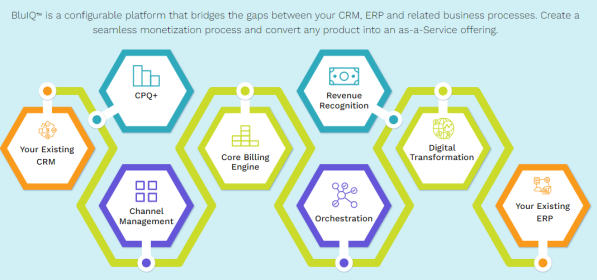
Having a robust and powerful mediation tool at this stage of the process is crucial for the success of consumption-based billing and for you as a service provider to efficiently deliver services on a consumption basis. This tool enables you to handle the complexities of data extraction, manipulation, and billing, ensuring accuracy and efficiency in the entire process.
After sending out the charges and invoices, the process of revenue management continues. It’s not just about generating invoices and collecting payments from customers. The financial and accounting data need to be integrated into the ERP system, which can present challenges.
Financial Management
Having a dashboard in the system is essential to provide a clear overview of sales, product performance, growth areas, market sectors, customer types, and service profitability. This data can help you identify which products and services generate higher margins, enabling better decision-making for business growth.
The success of consumption-based billing relies on a holistic approach that encompasses the entire process from customer acquisition to billing and revenue management. Automating and integrating the various components and data sources are essential to ensure scalability, efficiency, and profitability in the consumption-based business model.
To ensure seamless integration with the ERP or accounting system, the financial data must be presented in a format that the receiving system understands. This step is critical for accurate financial reporting, ensuring compliance, and streamlining financial operations.
In the finance and accounting domain, a robust GL (General Ledger) interface structure is essential. This allows you to configure the billing system to align with the chart of accounts in your ERP system. As a result, every financial transaction within the billing system will be accurately mapped to a specific entry point in the GL structure of your ERP.
By establishing this integration and synchronization between the billing system and ERP, you can avoid manual processing and ensure that data works seamlessly. Without such integration, you might face the burden of importing data as invoices and then manually allocating them to specific customers or mapping them to appropriate sales orders in the ERP platform.
Automating this process through a well-designed GL interface structure not only saves time and effort but also ensures accuracy and reduces the risk of errors. This automation facilitates a smooth flow of financial data, improves efficiency, and allows for a more streamlined financial operation between the billing and ERP systems.
Margin Analysis
To address this issue, it becomes vital to have a powerful billing and revenue management system that can perform detailed financial analysis and calculate profitability at a granular level. Such a system should provide insights into the margin earned on each item, making it easier for businesses to understand their financial performance on a product-by-product basis and make informed decisions accordingly.
Absolutely, relying on manual spreadsheet-based analysis for profitability tracking can indeed be time- consuming and error-prone. In contrast, a powerful and well-equipped billing and revenue management system, such as the Logics platform, can streamline this process by automatically tracking costs and revenues at a granular level.
When generating invoices in such a system, it will automatically calculate and apply the applicable costs for each item in every invoice, for every customer. This level of automation provides businesses with a clear understanding of their margins and profitability for each product, sector, and customer, in each period. With this detailed information readily available, businesses can focus on products that generate more revenue and make data-driven decisions to optimize their operations and growth.
Revenue Recognition
Ensuring accurate revenue recognition is crucial for the financial health and success of a business. Many ERP systems do offer revenue recognition capabilities, but obtaining accurate results often requires extensive configuration on both the ERP and billing system sides. This can involve manual steps and complex setup to ensure the revenue recognition process works seamlessly.
Having a well-equipped billing and revenue management system, like the Logics platform, can simplify the revenue recognition process. The system can automatically track revenue recognition based on predefined rules and configurations, reducing the need for manual intervention. This ensures accurate and timely revenue recognition, providing businesses with a clear picture of their financial performance and compliance with accounting standards.
In summary, having a robust billing and revenue management system can help fix revenue leaks, provide granular profitability information, and streamline revenue recognition processes, ultimately contributing to the overall success and healthiness of a business
…if a product is billed annually, there’s no need to manually define that it should be amortized over a year. The system already knows that the revenue collected and invoiced should be recognized over a 12-month period. Consequently, the system will automatically handle the GL recognition transactions, transitioning the revenue from deferred to current revenue, as the data is already available in the system.
Having a well-equipped billing and revenue management system, like the Logics platform, can simplify the revenue recognition process. The system can automatically track revenue recognition based on predefined rules and configurations, reducing the need for manual intervention. This ensures accurate and timely revenue recognition, providing businesses with a clear picture of their financial performance and compliance with accounting standards.
In summary, having a robust billing and revenue management system can help fix revenue leaks, provide granular profitability information, and streamline revenue recognition processes, ultimately contributing to the overall success and healthiness of a business
On the ERP side, a robust billing system will have integrated revenue recognition capabilities within the billing platform. This integration allows the system to automatically read all the relevant information and attributes related to revenue recognition according to accounting standards, such as GAAP. For instance, if a product is billed annually, there’s no need to manually define that it should be amortized over a year. The system already knows that the revenue collected and invoiced should be recognized over a 12-month period. Consequently, the system will automatically handle the GL recognition transactions, transitioning the revenue from deferred to current revenue, as the data is already available in the system. This is just one example of how automation can streamline revenue recognition and eliminate the need for extensive manual work and complex configurations across both systems, ensuring more effective revenue management for the business.
Final Thoughts
The transition to consumption-based billing represents a strategic evolution in how businesses charge for their services without altering the core services themselves. In the digital realm, service providers continue to deliver their valuable offerings, but they rethink their billing models to drive business growth and attract a broader customer base.
While the subscription concept remains intact, consumption-based billing introduces a more personalized and adaptable approach. By aligning charges with actual usage, businesses create pricing models that resonate with a wider range of customers. This enhanced flexibility empowers customers to select plans that precisely match their needs and consumption patterns.
This shift aligns with modern market trends, where customers increasingly seek tailored solutions and greater control over their expenditures. As businesses embrace consumption-based billing, they not only cater to customer preferences but also gain a competitive advantage, enhancing customer satisfaction and retention.
About BluLogix
Handling a full range of billing scenarios, from the very simple to the most advanced and complex, including multiple usage-based microtransactions per day, while servicing multiple channels and different tiers of customers and recurring subscriptions, BluLogix offers a cohesive overall approach to the recurring revenue monetization process.
Ready to see how it works? Book a demo today with one of our billing experts below and we’ll show you how BluLogix accelerates revenue growth, increases profitability, enables scalable processes, and empowers channels.
Reviews

Michael R.
President, Allnet Air Inc. - Telecommunications
Best Outsourced Billing for Mobility

Karen R.
Manager, Cloud Billing - Computer Software
BluLogix has been a great partner.
“Over the last several years, I have seen continual enhancements and additions to the platform. BluLogix has created a comprehensive solution for users. They provide great communication regarding upgrades and address concerns thoroughly and timely.”

Sara K.
Marketing, Graphic Design & Social Media Management - Marketing and Advertising
Fantastic platform. Recommend!

